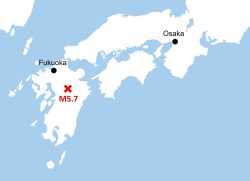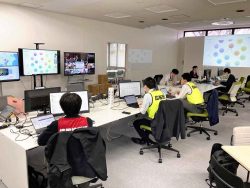Firefighters in Haneda Aircraft Accident Exposed to Harmful New Plastic from Burning Plane

The Land, Infrastructure, Transport and Tourism Ministry in Chiyoda Ward, Tokyo, in November 2020
2:00 JST, January 4, 2025
The Japan Airlines plane involved in the Jan. 2, 2024, accident at Haneda Airport was cutting-edge.
By weight, 53% of the Airbus A350-900’s main structures, including the fuselage, main wings and tail, are made of a compound material called carbon fiber-reinforced plastic (CFRP).
Since CFRP is lighter than aluminum alloy, the most common material used in aircraft, it is thought to improve fuel efficiency. The material is also said to be more resistant to decay.
The accident at Haneda Airport is the first case in which a CFRP aircraft burned down and was completely destroyed. According to the progress report by the Japan Transport Safety Board, every time the mangled remains of the aircraft were moved for post-accident investigations, large amounts of carbon fiber dust flew into the air.
The International Civil Aviation Organization warns that the dust could damage the eyes, throat, lungs and other organs if it cuts the skin or mucus membranes. However, firefighters and investigators working on-site on the day the accident occurred were not wearing sufficient protective gear.
Following the accident, the Land, Infrastructure, Transport and Tourism Ministry began encouraging airports across the nation to stock devices that supply clean air from a tank to a user wearing a full-face gas mask, and to have personnel who fight aircraft fires wear these respirators.
Progress reports by the JTSB are usually under 10 pages. However, the report on the accident is unusually large, coming in at 158 pages, and includes information on the firefighting that took plce.
Atsushi Shimamura, a member of the JTSB and an aviation expert, said: “Since each piece of factual information is extremely helpful in improving the safety of the airline industry, we included as much information as possible in the interim report. We didn’t want to wait for the final report.”
"Society" POPULAR ARTICLE
-

M4.9 Earthquake Hits Tokyo, Neighboring Prefectures
-

M7.5 Earthquake Hits Northern Japan; Tsunami Waves Observed in Hokkaido, Aomori and Iwate Prefectures
-

Tsukiji Market Urges Tourists to Avoid Visiting in Year-End
-

Israeli Tourists Refused Accommodation at Hotel in Japan’s Nagano Pref., Prompting Protest by Israeli Embassy and Probe by Prefecture
-

M5.7 Earthquake Hits Japan’s Kumamoto Pref., Measuring Upper 5 Intensity, No Tsunami Expected
JN ACCESS RANKING
-

Keidanren Chairman Yoshinobu Tsutsui Visits Kashiwazaki-Kariwa Nuclear Power Plant; Inspects New Emergency Safety System
-

Imports of Rare Earths from China Facing Delays, May Be Caused by Deterioration of Japan-China Relations
-

University of Tokyo Professor Discusses Japanese Economic Security in Interview Ahead of Forum
-

Japan Pulls out of Vietnam Nuclear Project, Complicating Hanoi’s Power Plans
-

Govt Aims to Expand NISA Program Lineup, Abolish Age Restriction






















